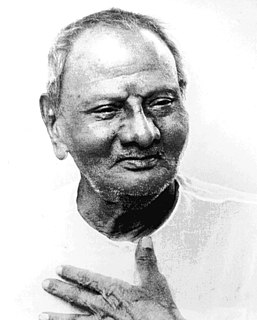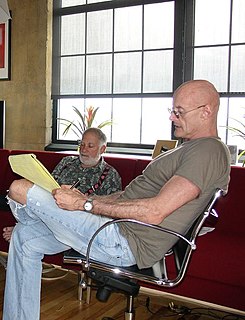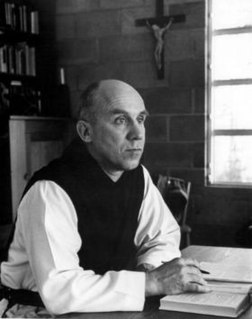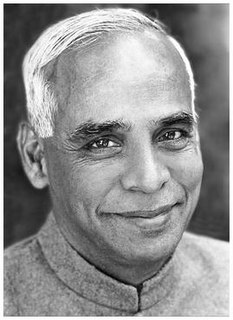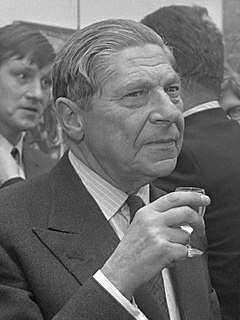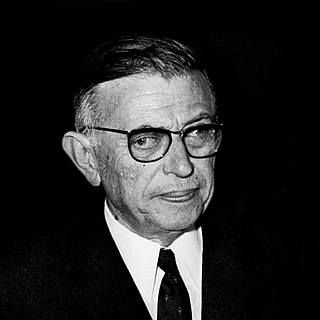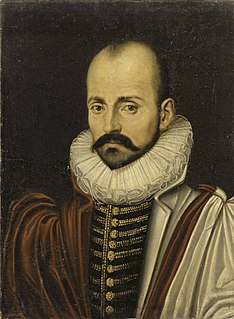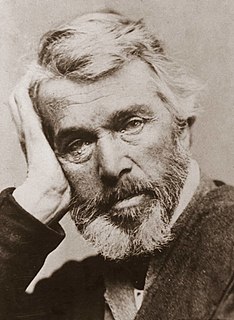A Quote by Sri Nisargadatta Maharaj
When the mind is quiet, we come to know ourselves as the pure witness. We withdraw from the experience and its experiencer and stand apart in pure awareness, which is between and beyond the two. The personality, based on self-identification, on imagining itself to be something: 'I am this, I am that', continues, but only as a part of the objective world. Its identification with the witness snaps.
Related Quotes
We are dominated by everything with which our self is identified. We can dominate and control everything from which we disidentify ourselves. The normal mistake we all make is to identify ourselves with some content of consciousness rather than with consciousness itself. Some people get their identity from their feelings, others from their thoughts, others from their social roles. But this identification with a part of the personality destroys the freedom which comes from the experience of the pure “I”.
The Witness is a huge step forward, and it is a necessary and important step in meditation, but it is not ultimate. When the Witness or the soul is finally undone, then the Witness dissolves into everything that is witnessed. The subject/object duality collapses and there is only pure nondual awareness, which is very simple, very obvious.
Introspection is self-improvement and therefore introspection is self-centeredness. Awareness is not self-improvement. On the contrary, it is the ending of the self, of the “I,” with all its peculiar idiosyncrasies, memories, demands, and pursuits. In introspection there is identification and condemnation. In awareness there is no condemnation or identification; therefore, there is no self-improvement. There is a vast difference between the two.
Pay attention to the gap - the gap between two thoughts, the brief, silent space between words in a conversation, between the notes of a piano or flute, or the gap between the in-breath and the out-breath. When you pay attention to those gaps, awareness of 'something' becomes - just awareness. The formless dimension of pure conciousness arises from within you and replaces identification with form.
With self-awareness you grow more intelligent. In awareness you learn, in self-awareness you learn about yourself. Of course, you can only learn what you are not. To know what you are, you must go beyond the mind. Awareness is the point at which the mind reaches out beyond itself into reality. In awareness you seek not what pleases, but what is true.
Witness the witness itself - and... the ultimate ecstasy is created. Start watching your thoughts but don't stop there... One more thing has to be done, one more step: now watch the watcher... Nothing else is left, only you are. By watching the mind, the mind disappears. By watching the witness, the witness expands and becomes universal.
As modern physics started with the Newtonian revolution, so modern philosophy starts with what one might call the Cartesian Catastrophe. The catastrophe consisted in the splitting up of the world into the realms of matter and mind, and the identification of 'mind' with conscious thinking. The result of this identification was the shallow rationalism of l' esprit Cartesien, and an impoverishment of psychology which it took three centuries to remedy even in part.
To remain attached to the temporal, to the changing is to remain within the world of misery because the temporal will be taken away. You have invested so much in it but one day everything is taken away. Then it is natural to feel miserable. Misery is rooted in attachment to the body and bliss is rooted in non-attachment to the body; hence all the great masters have been teaching methods and means of non-attachment, of getting disidentified with the body, with the mind, with everything surrounds you, and of just remaining a pure witness. That's what we are: pure witnessing, pure awareness.
If we only identify with the mortal world, then we identify with a level of scarcity and lack and brokenness, and that will be our experience. But if we shift our experience of self-identification - and this is what enlightenment is - from the body-self to the spiritual-self, then we place ourselves under an entirely different set of possibilities and probabilities.
It is only through meditation that purity comes. Meditation means jumping out of the mind. There is no need to purify the mind, it can be put aside. One can become disidentified with the mind. To know "I am not the mind," is real purity because then you are only consciousness, awareness, a witnessing. To live twenty-four hours a day as a witness is the way of the sannyasin.
One can ask why the I has to appear in the cogito {Descartes’ argument “I think therefore I am.}, since the cogito, if used rightly, is the awareness of pure consciousness, not directed at any fact or action. In fact the I is not necessary here, since it is never united directly to consciousness. One can even imagine a pure and self-aware consciousness which thinks of itself as impersonal spontaneity.
